Tom Coles
Residency at National Institute of Design (NID)
My Trip to Kutch
Posted by Tom Coles on 19th November 2006
On Wednesday 8th November I travelled to Bhuj in Kutch. This area of India is rich with artisans and craftspeople making a living from their skill. Skills that have been passed down through generations over hundreds of years.The aim of my visit was to see as many of the traditional crafts as possible and document my findings. I was hoping to find an interesting use of materials, or a beautiful form, an innovative manufacturing process, or a clever solution to a problem, a sublime use of colour, or some carefully engineered tools.
I was not disappointed. We travelled from village to village; each one offered a different craft and a new set of skills. I was struck by the proud, hardworking, skilled craftsmen and women that I met. Their livelihood depends solely on their skills – their ability to use their hands to generate a product that others want to buy. It’s a simple and honest concept that has been the survival of generations of people in these villages.
Honesty and simplicity is a thread that runs through all aspects of the crafts people’s lives. Their work is generated using locally sourced materials – transportation is expensive, so the craftspeople make use of what is readily available. The tools that are used are well-designed products in themselves. The tools that I use in my workshop are versatile, often able to perform a number of tasks. Here, the tools are designed for a specific purpose. An organic design process has taken place, where a craftsperson has developed a tool or jig over a period of time to assist with a process. Sometimes the tools are a slight adaptation of a ready-made, off the shelf tool that could be purchased cheaply at the market. I am in ore of this practical approach to problem solving.
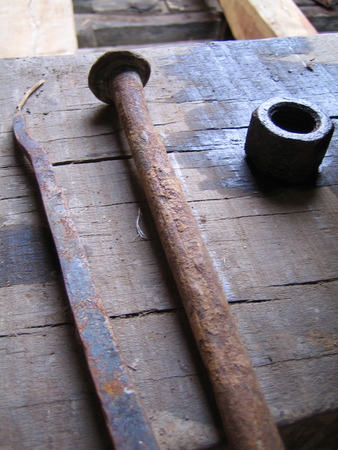
some tools in the wood carver's workshop
I was intrigued by the crafts people’s workspaces. They too are a product of necessity. The lacquer-worker uses a transportable lathe and carries his lacquer and tools in an old suitcase. He works on the floor, so does not require a bench. His lathe is powered by hand, so he has no need for electricity. The pieces that he makes are small, so he has no need for any assistance. Therefore his workshop is as simple as a piece of canvas stretched over a bamboo frame, to keep him shaded from the sun whilst he works.
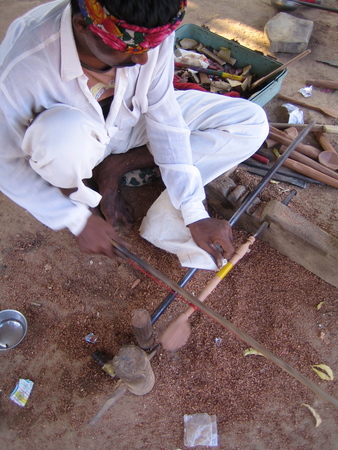
the lacquer worker and his portable lathe
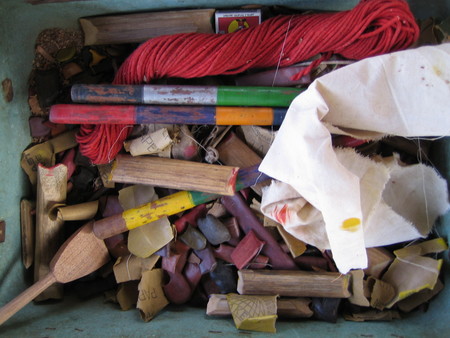
inside the lacquer worker's suitcase
The wood carver’s workshop has evolved through their individual requirements. They are processing larger pieces of timber, so need power and more hands to assist. They use seasoned timber so it requires a dry, shaded space to sit. The products produced; doors, cupboards, beds are large and complex so undergo a number of manufacturing processes before they are complete. Again, there are no benches – the craftspeople prefer to work on the floor, using their feet to cramp work securely. The workshop therefore is a large, open space it has power and has identified areas for different processes.
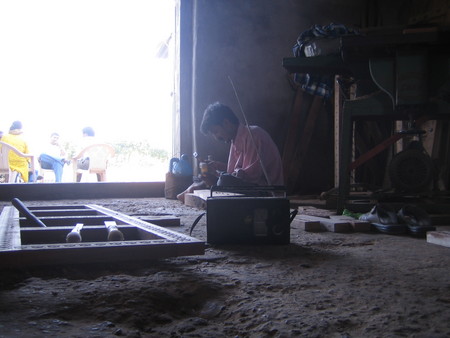
a wood carver makes use of the natural light
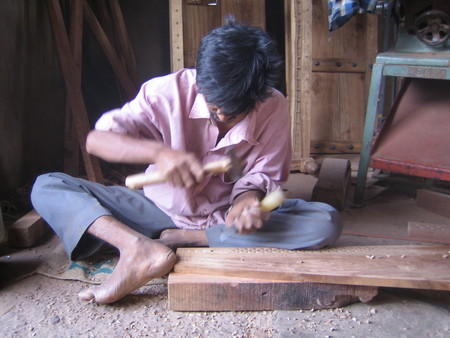
a wood carver uses his feet to secure his work
The work being produced by the craftspeople is a direct result of their market. A lack of surplus materials means that experimentation is out of the question. They only make what they know they can sell – this is what happens when your livelihood depends on your success at market. The lacquer-worker produces spoons, spinning tops, children’s rattles. The products are simply a shape in order to express a skill. In this way each one is a piece of artwork; unique and an expression of the artists movements. The wood carvers are able to work to order, their stock products have made way for special requests for bespoke doors, window frames, beds, shutters and cabinets. In this respect the wood-carvers have been able to adapt with their market’s requirements.
The craftspeople were kind enough to show me around their homes. The mud huts, with straw roofs were extremely simple structures but in complete harmony with their craft. The homes were basic but beautifully decorated with carved mud interiors and exterior walls painted with motifs, patterns and symbols of Indian Gods. The homes were skilfully and carefully made. The craftsman’s pride oozed from his home – his home is a symbol that he has mastered his craft.
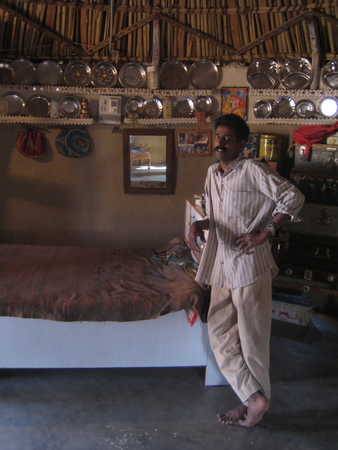
inside a wood carver's home
As we made our way back through the desert, leaving the isolated villages behind, I wondered whether the villages would still be there in fifty years time. Will the next generation build on the achievements of their parents, or will they be drawn into the big city in search of a more colourful, exciting life?
One thing is clear - the crafts people can only respond to a market. If a market for their products or skills exists, then the crafts will prosper. But keeping that market alive is tricky. To rely on a market that buys craftwork as a historical souvenir or a symbol of a romantic ideal, is short sighted. The long-term survival of the crafts depends on the crafts people’s ability to develop new products and ways of presenting their skills. There is support for the crafts people; my trip was arranged by an NGO that is committed to promoting the traditional crafts in the region. Through intervention from designers and increased public awareness, the NGO is achieving its goals.
One of the problems facing the organisations and designers working with the crafts-people is communication. For example it is not possible to simply give the lacquer-workers a working drawing of a component and expect them to make it. They are more artists than engineers; their manufacturing process is not attuned to the repeat manufacture of precision components. The challenge for the designer is to allow for tolerances and visual differentiation between components. Surely though, this is the potentially exciting aspect of working with the traditional craftspeople.
the flower market
Posted by Tom Coles on 19th October 2006
On Monday I went to the flower market here in Ahmedabad. To get to the market, I walked from NID along the Sardar Bridge.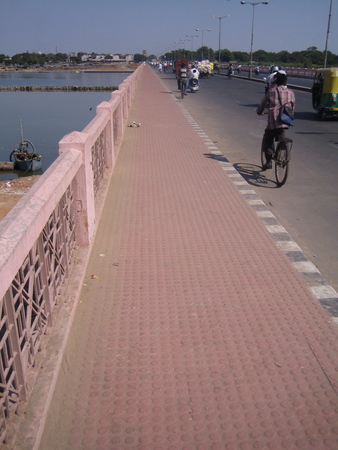
The sight of a sweating white man wilting under the mid-day sun tempted a kind young man to stop and offer me a ride on the back of his bicycle. Of course I obliged. I was concentrating too hard to get any photos unfortunately.
Just outside the market entrance, some Goats were feasting on the discarded flowers.
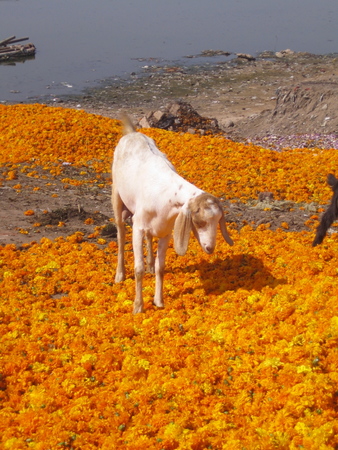
I arrived at the market gates with some slight trepidation. I wasn't really sure what was inside; I'd just spotted the entrance when I shot past in an auto-rickshaw on my way into NID earlier in the day. I was also wondering what the reception would be like for me inside. Even so, my curiosity won over and I wondered in.
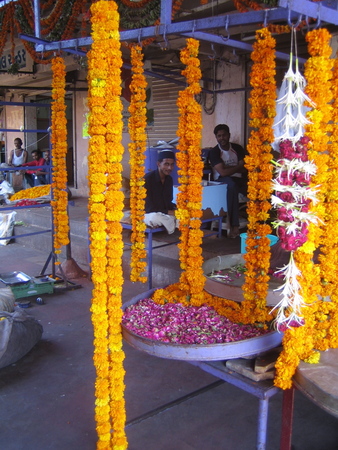
I was relieved to find a friendly, laid-back environment. I should have known - this is India after all. Streams of beautiful colours hung from the ceiling. The very back of the market intrigued me. This is where the flowers loose their stems and are threaded together.
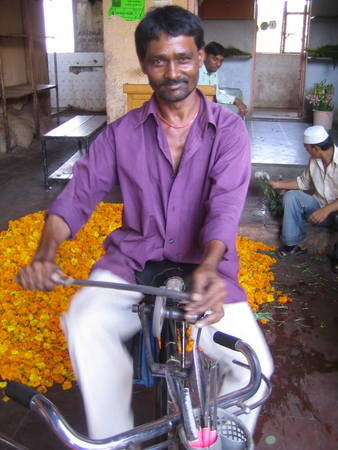
The knife gets sharpened, and then it is put to good use. What strikes me about the culture here, is that people are so resourceful. Processes are achieved using practical, cheap and often low- tech solutions.
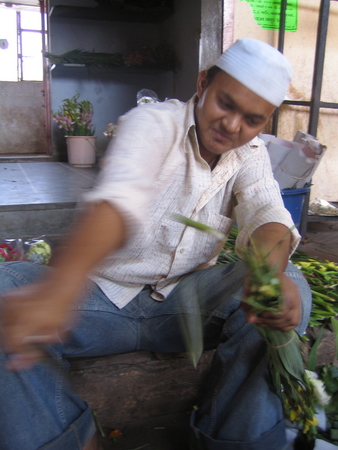
Just outside the market I was tapped on the shoulder by someone who was keen to show me how good he is at blowing bubbles.
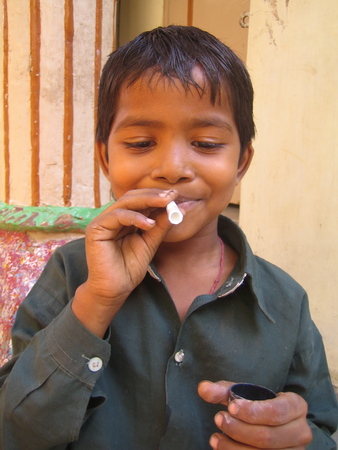
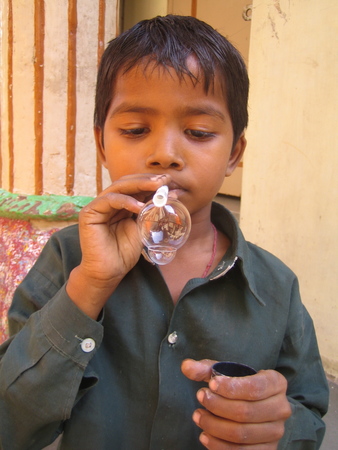
from the airport to the house
Posted by Tom Coles on 6th October 2006
I felt a huge relief upon my arrival at Ahmedabad airport to see a slightly anxious looking man holding a sign, it read:
Mr Tom
HAT exchange
Arts reverie
I had made it. After all the planning, the waiting and the travelling I was in India, being bundled into the back of a waiting car. I had absolutely no control over the situation, I was unable to communicate through usual dialogue, I had no idea where I was or where I was heading….it felt wonderful.
My brain was on overload. I had entered a completely different world. With eyes wide open, I swigged on a cold bottle of water and took in the noise, colours, smells and heat. We seemed to wind around the city for twenty minutes or so before turning through a stone arch. Narrowly avoiding the bicycles, cows and people we threaded our way up the tiny street until reaching a bright, quaint, clean building where we came to an abrupt stop.
The door of the house opened and there greeted me a familiar face. It was Anupa, “welcome to India Tom”.
(See my first impressions of Ahmedabad in the Images section)
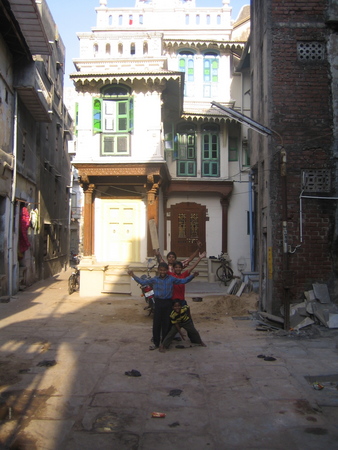

Click on image to open QuickTime movie
"ARTIST'S TALK"
Tom Coles talks to conference during cHAT week at Sanskriti, Delhi, India. March 2007





